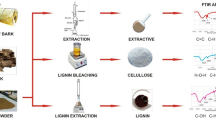Abstract
Scots pine heartwood specimens were exposed to mould in controlled humid atmosphere (RH 95%, T =20 °C) and the responses of electrical impedance and Fourier transform infrared spectroscopy (EIS and FTIR) methods were studied. The concentration of methanol soluble heartwood extractives and the emission of volatile organic compounds (VOC) were determined from the parallel samples. Results show that the spectral responses and VOC emissions were related to the mould development. According to this study, VOC emissions might be used for discriminating mould susceptible and resistant samples. FTIR spectra showed that the relation of amide (1655 cm-1) and carbonyl peaks (1736 cm-1) was significantly affected by mould. In the EIS analyses, there also were electrical parameters, which were significantly affected by mould. In conclusion, both spectral methods hold potential for non-destructive mould detection and monitoring of mould development.
Zusammenfassung
Kiefernkernholzproben wurden im kontrollierten Feuchtklima (rLf 95%, T = 20 °C) Schimmel ausgesetzt und mittels elektrischer Impedanzspektroskopie (EIS) und Fourieranalyse (FTIR) untersucht. Die Konzentration an methanollöslichen Kernholzextraktstoffen und die Emission flüchtiger organischer Stoffe (VOC) wurden an Vergleichsproben bestimmt. Die Ergebnisse zeigten, dass die Banden der Spektralanalysen und die VOC-Emissionen von der Schimmelentwicklung abhingen. Gemäß dieser Studie können VOC-Emissionen für die Unterscheidung von schimmelanfälligen und resistenten Proben verwendet werden. FTIR-Spektren zeigten, dass das Verhältnis zwischen den Amid- (1655 cm-1) und Karbonyl-Peakhöhen (1735 cm-1) signifikant vom Schimmel beeinflusst wurde. Die EIS-Analysen zeigten, dass elektrische Parameter ebenfalls signifikant vom Schimmel beeinflusst wurden. Zusammenfassend kann gesagt werden, dass beide Verfahren eine Möglichkeit für die zerstörungsfreie Schimmelerkennung und Überwachung der Schimmelentwicklung bieten.
Similar content being viewed by others
References
Backa S, Brolin A, Nilsson T (2001) Characterisation of Fungal Degraded Birch Wood by FTIR and Py-GC. Holzforschung 55(3):225–232
Futschik K, Pfutzner H, Nussbaum K (1995) Selective detection of micro-organisms by use of electrode impedance. Proc. IX Int. Conf. Electrical Bio-impedance, September 26–30, Heidelberg, Germany, pp 79–82
Grimnes SG, Martinsen OG (2000) Bioimpedance and bioelectricity basics. Academic Press, London, UK, p 375
Harju AM, Venäläinen M (2006) Measuring the decay resistance of Scots pine heartwood indirectly by the Folin-Ciocalteu assay. Can J For Res 36:1797–1804
Hause LL, Komorowski RA, Gayon F (1981) Electrode and Electrolyte Impedance in the Detection of Bacterial Growth. IEEE Trans Biomed Eng BME-28:403–410
Jilkine K, Gough KM, Julian R, Kaminskyj SGW (2008) A sensitive method for examining whole-cell biochemical composition in single cells of filamentous fungi using synchrotron FTIR spectromicroscopy. J Inorg Chem 102:540–546
Kabir MF, Daud WM, Khalid KB, Sidek HAA (2000) Equivalent circuit modeling of the dielectric properties of rubber wood at low frequency. Wood Fiber Sci 32(4):450–457
Nerg A-M, Heijari J, Noldt U, Viitanen H, Vuorinen M, Kainulainen P, Holopainen JK (2004) Significance of wood terpenoids in the resistance of Scots pine provenances against the old house borer Hylotrupes bajulus and brown rot fungus Coniophora puteana. J Chem Ecol 30(1):125–141
Pandey KK, Pitman AJ (2003) FTIR studies of the changes in wood chemistry following decay by brown-rot and white-rot fungi. Int Biodeterior Biodegrad 52(3):151–160
Repo T (1993) Impedance spectroscopy and temperature acclimation of forest trees. Dissertation. Univ. of Joensuu, Finland, p 53
Repo T, Zhang MIN (1993) Modelling woody plant tissues using a distributed electrical circuit. J Exp Bot 44:977–982
Stewart GN (1899) Changes produced by the growth of bacteria in the molecular concentration and electrical conductivity of culture media. J Exp Med 4:235–243
Theander O, Bjurman J, Boutelje J (1993) Increase in the content of low-molecular carbohydrates at lumber surfaces during drying and correlation with nitrogen content yellowing and mould growth. Wood Sci Technol 27:381–389
Tiitta M, Kainulainen P, Harju AM, Venäläinen M, Manninen A-M, Vuorinen M, Viitanen H (2003) Comparing the effect of chemical and physical properties on complex electrical impedance of Scots pine wood. Holzforschung 57:433–439
Tiitta M (2006) Non-destructive methods for characterisation of wood material. Dissertation. Univ. of Kuopio, Finland, p 70
Ur A, Brown D (1974) Rapid detection of bacterial activity using impedance measurements. IEEE Trans Biomed Eng BME-9:203–205
Viitanen H, Ritschkoff A (1991) Mould growth in pine and spruce sapwood in relation to air humidity and temperature. Uppsala. The Swedish Univ Agr Sci, Dept For Prod, Rep no 221, p 40
Viitanen H, Villberg K, Saarela K (2000) New method to find out the volatile organic compounds (VOC) of wooden material. 31th Ann Meet IRGWP, May 14–19, Kona Hawaii. Int Res Group Wood Pres IRG/WP 00-20189, p 6
Author information
Authors and Affiliations
Corresponding author
Rights and permissions
About this article
Cite this article
Tiitta, M., Tomppo, L., Järnström, H. et al. Spectral and chemical analyses of mould development on Scots pine heartwood . Eur. J. Wood Prod. 67, 151–158 (2009). https://doi.org/10.1007/s00107-008-0298-5
Published:
Issue Date:
DOI: https://doi.org/10.1007/s00107-008-0298-5




